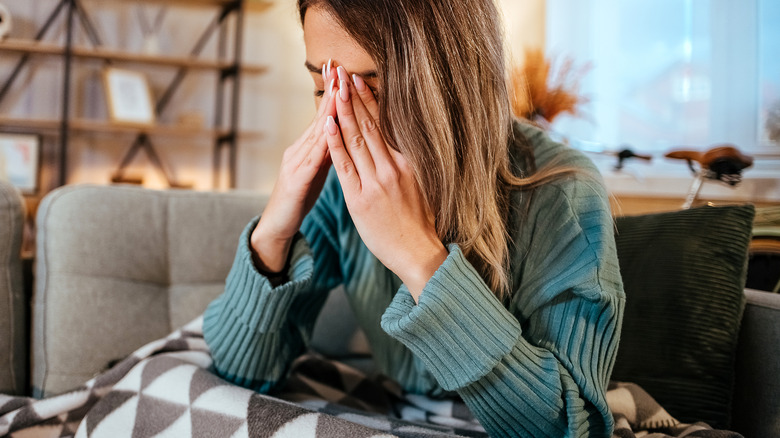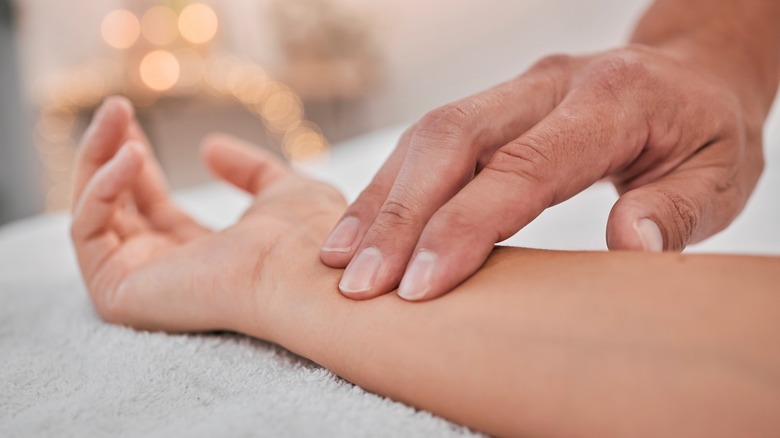Turns Out We Have A Button To Stop Nausea Fast. Here's How To Find It
Remember when you and your friends took off on that long-awaited road trip? Everyone was in good cheer, but you were busy fighting off the urge to barf and feeling carsick the entire time. What about the time you took a boat ride that last a few days? Did you wake up feeling nauseous?
Feeling motion sickness, sea sickness, and nausea in general can be very unpleasant. The sensation is often too overwhelming for you to focus on anything else. These are times when you wish you could stop nausea with the push of a button. But experts say that thanks to traditional Chinese medicine (TCM) and acupressure, you can: Simply locate the acupoint called Pericardium 6 or P6 that's on the inside of your wrist (per WebMD).
Hold your hand out with your palm facing up. Take your other hand and bring three fingers (your index, middle, and ring finger) together and place them at the base of your palm in the outstretched hand. Next, bring your thumb up to the halfway point across your wrist and place it there (now you should have four fingers across your wrist with the thumb located lower than the rest). Remove all fingers except the thumb, which should be comfortably resting inside between two tendons (the strong tissue that connects your muscles to your bones). Apply gentle yet firm pressure to P6. You can massage the area with your thumb too. Continue for 2 to 3 minutes.
How does this acupressure button work?
Unlike acupuncture, which involves needles, acupressure is about using gentle pressure via your fingers to stimulate acupoints in your body. New York City-based holistic health practitioner Shari Auth told Well+Good, "Acupoints are located where blood, nerve, lymph, and connective tissue meet. Stimulating an acupoint sends a message to the brain that alters brain chemistry and tells the body to react to achieve a desired result." According to TCM, our body's energy system, known as qi, runs through meridians that are located all over our body. When you stimulate an acupoint, you're basically realigning certain problematic spots in a meridan to facilitate an easier flow of energy.
While this might sound fantastical to some, using acupuncture to relieve pain, nausea, and even the symptoms of certain chronic illnesses has found its way into modern medicine. A 2013 study published in the journal PLOS ONE found that stimulating P6 reduced post-operative nausea. You might be able to cure everything from indigestion-related sickness and hangover nausea to motion sickness with this hack. And this isn't the only button you can push, either. To name some more, there's the Stomach 36, which is located on your shin bone, the Large Intestine 4 between your thumb and index finger, the Liver 3 on the top of your foot, and the Bladder 20 at the sides of your spine.
Things to keep in mind when stimulating Pericardium 6
Pericardium 6 is probably one of the most widely known acupoints to combat nausea. Some recommend it for anxiety relief, too.
While it might sound simple to locate the button on your wrist, there are a few things you should be aware of before trying this out. For starters, make sure there are no open wounds or skin disruptions that might worsen from increased pressure on the area. Secondly, while this is a recommended pressure point for post-operative nausea, you have to be mindful of any medical devices like intravenous lines on your wrist or complications like lymphedema or swelling. Ask your healthcare provider before you try anything.
When you're performing the acupressure technique, you should feel a slight twinge of ache deep in your wrist but not pain. Be mindful of long fingernails that might injure your skin when you push down on it. It is also important to know which situations call for this fast-relief hack and which ones don't. For example, if you've been feeling sick for over two days, you should see a doctor for nausea and vomiting. The benefits of acupressure, much like most other forms of alternative medicine, are still being researched. While locating and stimulating pressure points might be a cost-effective and efficient way to relieve everyday woes like headaches and nausea, it is better to seek out the advice of a healthcare professional for more serious health concerns.


